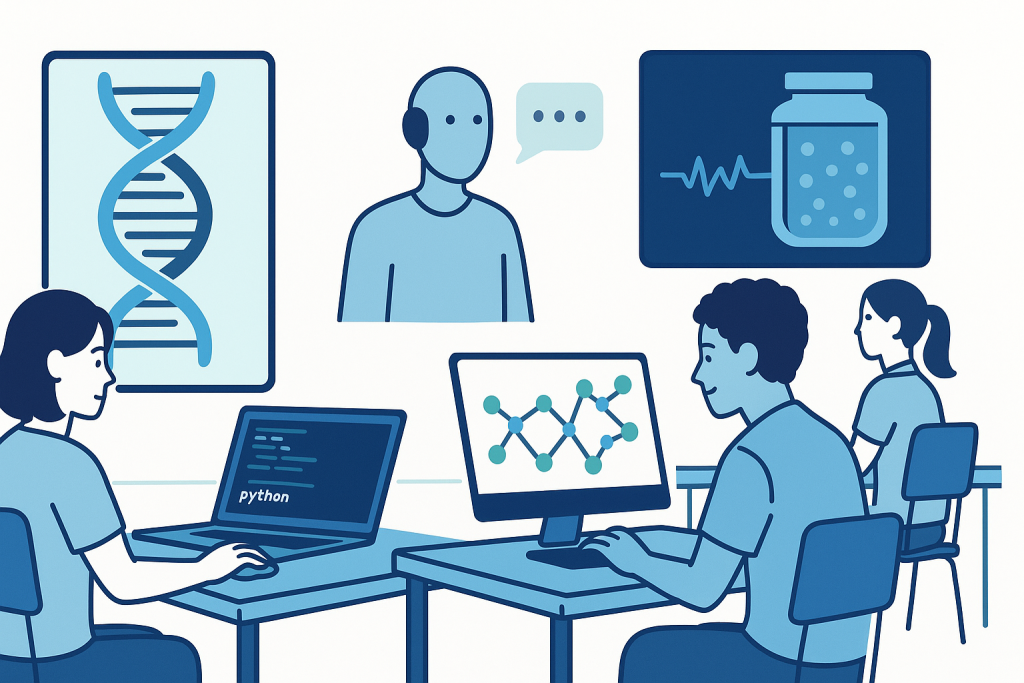Tomorrow’s classrooms won’t just study life—they’ll help design it.
The Next Evolution of STEM Education
By 2035, science education will look nothing like today’s lab bench model.
Instead of microscopes and test tubes alone, students will use digital bioreactors, AI-powered lab assistants, and open-source genome design platforms.
In this future classroom, biology, coding, and ethics converge into a unified system of learning. Students won’t just observe living systems — they’ll simulate, design, and iterate them safely within digital environments.
The goal isn’t to turn every student into a bioengineer. It’s to cultivate systems thinkers who understand life as programmable, interconnected, and ethically complex.
Digital Labs That Think and Learn
The traditional lab report will evolve into a live data conversation.
AI tutors will help students design experiments, visualize genetic outcomes, and interpret biological data in real time. A middle schooler could:
- Simulate a genetic trait across virtual generations.
- Grow safe microbial cultures in a closed bioreactor pod.
- Use Python code to model population dynamics or protein folding.
Every experiment becomes a feedback loop between biology and computation — teaching students how nature processes information.
Digital labs won’t replace curiosity; they’ll amplify it, turning complex systems into accessible, interactive explorations.
Open-Source Biology: Learning by Designing
The rise of open science is changing who gets to experiment with life.
By 2035, biology education will draw heavily from the open-source movement. Students will access shared databases of DNA sequences, ecological data, and bioengineering designs.
They’ll use platforms like:
- Benchling or Geneious-style classroom editions for virtual gene editing.
- AI-based “BioCompilers” that translate natural language into biological models.
- Collaborative bio-clouds where teams can upload, share, and simulate their designs.
This democratization of biology education teaches not just technical skills, but also collaboration, transparency, and ethics — the same principles that drive modern science.
AI Tutors and Ethical Guardians
Artificial intelligence will play the dual role of mentor and monitor.
AI tutors will guide students through experiments while enforcing safety and ethical constraints. A student proposing a risky design won’t be scolded — they’ll be prompted to reflect:
- What could happen if this system interacted with the environment?
- What permissions or safeguards are required?
- How do we balance innovation with responsibility?
By embedding ethics into the workflow, classrooms will produce not just inventors, but responsible innovators.
The New Core Curriculum: Grow, Simulate, Code
In the School Lab of the Future, three learning modes will form the backbone of STEM education:
1. Grow:
Students cultivate living systems — from cells to ecosystems — learning how growth and adaptation work in nature and design.
2. Simulate:
They model biological systems digitally, using AI and coding to predict outcomes before experimenting physically.
3. Code:
They write logic for life itself, from genetic circuits to environmental feedback loops. Code becomes a creative medium for biology.
Together, these modes teach students how to think in systems — physical, digital, and ethical.
Learning Through Living Systems
Biology is the ultimate systems science.
It teaches resilience, feedback, and adaptation — concepts that apply far beyond the lab. Future classrooms will use living systems as models for:
- Climate engineering and sustainability.
- Health and genetic literacy.
- Ethical AI and machine learning.
By seeing code as a living language and life as an evolving system, students will bridge the gap between creation and stewardship.
Preparing for the Living Economy
The world economy is moving from mechanical to biological logic.
Careers in synthetic biology, sustainable design, bioinformatics, and agricultural tech will dominate the next decades. The School Lab of the Future equips students with:
- Adaptive thinking: navigating rapidly evolving technologies.
- Interdisciplinary fluency: linking biology, computing, and design.
- Ethical foresight: ensuring technology serves life, not the other way around.
Education will no longer prepare students for one profession — it will prepare them for continuous reinvention in a world built on living technologies.
The Takeaway
By 2035, the lab will no longer be a room — it will be a network.
Students will grow cultures, simulate genomes, and code biological logic with the same fluency they now use spreadsheets and apps.
The School Lab of the Future will teach not just how to understand life, but how to collaborate with it — responsibly, creatively, and intelligently.
The future of STEM isn’t mechanical — it’s alive.


